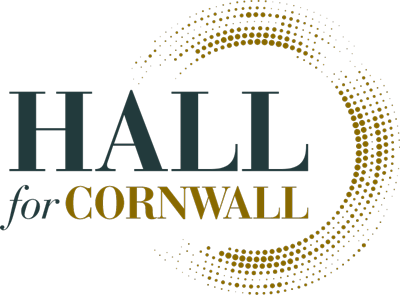
Re-conditioned army vehicles stand ready to hand over to troops towards the end of WWII. Army vehicles were positioned along Back Quay outside City Hall after being worked on at HTP Motors, now the Pannier Market. Photo courtesy of Collection of the Royal Institution of Cornwall.
The Annex
In 1925, the existing market house at Back Quay was refurbished into a 1,000-capacity public hall where a variety of performances, shows and balls would be held over the next century. It was during these infrastructural alterations that an annex was added to the left of the main stage in the new City Hall, which functioned as a smaller ad hoc performance venue for local bands to perform and for the wider community to stage their own dances and events. In 1940 it undertook a new role which would see a temporary pause in performances.

Image Credit: An example of a Community Feeding Centre similar in style to the one in the Annex of City Hall. Released under CC Licence from the collection of the Imperial War Museum
Gladys Roberts of Illogan subsequently remembers how the space was refashioned as a British Restaurant where cheap meals could be purchased by the local community at a price of nine pence in order to supplement their rations. Originally referred to as ‘Community Feeding Centres’, British Restaurants were thus communal kitchens established by the Ministry of Food at the start of the war to provide help to those who were bombed out of their homes, had run out of rations or who otherwise required assistance. It is estimated that in 1943, over 2,000 British Restaurants served upwards of 600,000 inexpensive meals a day.
City Halll was subsequently home to one of these 2,000 restaurants and thereby played a crucial role in aiding to alleviate an enormous amount of distress for those who depended on the non-profit service in their hour of need. Having begun in civic centres across the country in 1940, the initiative was eventually mothballed in 1947 and the annex was able to resume its original function with bands, performances and community events once again returning to this corner of City Hall.
The US Army in Truro
The US army arrived in Truro in 1943, establishing multiple camps across the city in Treliske, St. Clement, Devoran, Perranwell, Shortlanesend and Chacewater to name a few. The closest base to City Hall was in Boscawen Park where the 531st Engineer Shore Regiment and 1st Special Brigade camped, the former being responsible for the production of concreate barges which were stored along the banks of the River Fal before being used to ferry ammunition across the channel.
Owing to the growing population of GIs in Truro, City Hall’s Regent Cinema was soon commandeered to house the US Army postal exchange (PX) which served all the camps in and around the city. Not only did the PX function as a make shift canteen where meals and snacks were served, it also held film screenings, variety shows and dances for the troops and local woman to enjoy. The GIs even arranged variety shows for local children to attend at Christmas and Easter.

Boscawen Street, c. 1950. Image credit courtesy of Cornish Memory.
Of particular significance is the New Year show which was staged as a gesture of good will by the US Army Command after a fight had erupted between black and white GIs outside the Globe Public House. A whole week’s worth of army issued sweet rations were thus dispersed to attendees, with Neville Harcourt Paddy subsequently remembering how ‘everyone attending was treated to sweets, chewing gum and candy and a paper bag filled with chocolate powder … I can remember thinking at the time “what wonderful generous people the Americans were.”’
In this sense therefore, City Hall was able to retain its entertainment value whilst still also providing practical assistance and much needed services to both its local and new found global community throughout the Second World War.

‘American troops at Grampound Road near Truro, 1944.’ – image credit: the Cornwall Centre, part of Cornwall Libraries.
Find out more
Listen to Roger Heayn’s memories of life as a boy in Truro during WWII.


